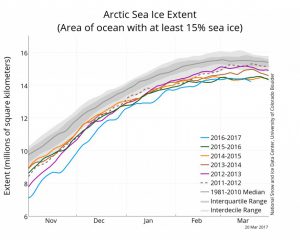In a report this week in the Washington Post, “According to the National Snow and Ice Data Center, the sheet of Arctic sea ice, which expands and contracts in an annual cycle, probably reached its maximum size this year on March 7, when it spanned 14.42 million square kilometers, or 5.57 million square miles, atop the Arctic ocean. That’s an enormous area, but it’s also the smallest winter maximum extent ever observed in records dating to 1979.” This means that sea ice levels are continuing to decline, even in the winter, although of course there is still a seasonal cycle in ice related to temperatures and energy from the sun. Because of that, the coming summer sea ice extent is also likely to be lower than ever measured, since it is unlikely that a large pool of cold air will suddenly appear to free the Arctic Ocean so late in the winter season. The impacts of all of this open ocean on weather and climate in the United States are uncertain but are likely to continue to contribute to weather extremes and a continued trend to warmer temperatures.
You can read more about it at the Washington Post here or the Weather Network here.
